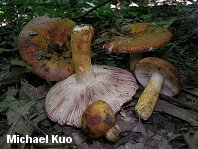North American Foetid Russulas 
[ Basidiomycetes > Russulales > Russulaceae > Russula . . . ]
by Michael Kuo
Any number of Russula species could be said to have a "foetid" odor. A quick search through Russula literature renders species that smell "of shrimp or crab," "of cooked apples," "of old wine-casks," "rancid, cheesy, or oily," "disagreeable," "odd," and so on. One group of russulas, however, is characterized by a smell that ranges from sweetly waxy or spermatic, to strongly fragrant and reminiscent of maraschino cherries or benzaldehyde. The odor (or, better said, the range of odors) is hard to describe, but fairly unmistakeable once you are familiar with it. Russulas with this odor, taxonomically speaking, make up subsection Foetentinae of section Ingratae. Most of the species have cream-colored spore prints and distinctive tastes (waxy, oily, acrid, etc.), and the cap colors in the group range from brown to versions of yellow and orange.
The key below treats the mushrooms in this group, rather than any russula that could conceivably be described as having a foul or "foetid" smell.
The major species among the foetid russulas are fairly easily distinguished without a microscope on the basis of close observation, taste, and odor. However, in some instances a microscope is probably needed to be sure of identification. As is usually the case in mushroom identification, you will fare much better if you have collected fresh specimens representing several stages of development.



